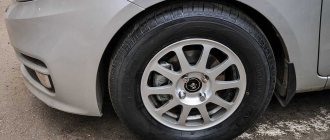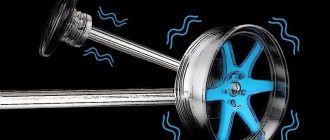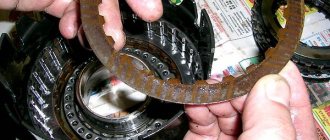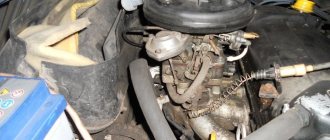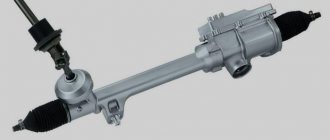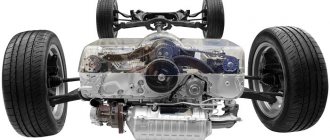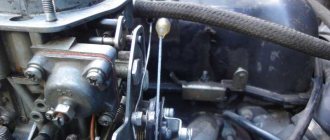A fairly common car malfunction is vibration of the steering wheel at a speed of 90-100 km per hour. At low speed everything may be fine. But as it increases, the steering wheel begins to “come to life” in your hands. And even when driving on a flat road. It often happens that this phenomenon appears gradually, from a small, barely noticeable vibration to real trembling, when not only the steering wheel, but also the column shakes. Following this, the instrument panel and interior trim rattle so much that it becomes impossible to drive. It is worth noting that this problem appears not only on domestic cars, but also on many foreign cars. Commercial vehicles, for example, Gazelle, are no exception. When steering wheel vibration appears at a speed of 90-100, the main reasons can be very different. So let's look at them in detail.
Incorrect balancing
Poorly balanced wheels are the main reason why the steering wheel vibrates at speeds of 90-100 km/h.
Dirt or icy snow may stick to the disc, often on the inner side, invisible to the eye. At low speeds, this additional load does not manifest itself in any way. But as it increases, the centrifugal force from the center of the wheel also increases. The imbalance will be significant, so the wheel begins to jerk, causing vibration to reverberate through the steering wheel. This malfunction can be eliminated by simply cleaning the wheel disk from the outside and inside.
Self-diagnosis
Determining, using a visual inspection, the exact cause of vibration of the steering wheel when driving is not immediately possible, even for professionals. To facilitate diagnostics when identifying a defect, you must:
- Drive onto a section of flat and dry road that allows your car to reach a speed of up to 100 km/h.
- Accelerate smoothly to the maximum permitted speed.
- Drive 1-2 km without acceleration in this mode.
- Reduce speed to minimum.
You should pay attention to what mode of movement vibration appears, how strong it is, whether longitudinal or transverse vibrations predominate and at what moment it disappears. These are the questions that specialists will ask you when you contact a professional service center.
It should be taken into account that on some models of the domestic and Chinese automobile industry, a slight vibration on the steering wheel is acceptable by the manufacturer and only with increasing amplitudes, it is necessary to take measures to identify the causes of the occurrence.
Tire imbalance
The reason for this phenomenon may also be defects in the rubber itself as a result of hitting an obstacle or falling into a hole (often at high speed), which causes the carcass elements on the tire to deteriorate and it takes on an irregular shape. This defect is called a “hernia.” It is almost impossible to correct it, but you can try to correct it by balancing the wheel. But even in this case, the steering wheel will vibrate at speeds of 90-100. What to do in this situation? Such a tire will still no longer work as it should, and it will soon have to be changed.
Braking system malfunction
The appearance of “beating” of the steering wheel during braking is a sign of a malfunction of parts of the brake system. In this case, you need to check:
- Disks.
- Drums.
- Degree of wear and reliability of installation of linings.
Premature failure of these components indicates a manufacturing defect, installation of uncertified spare parts or improper operation (overheating after prolonged braking). In this case, it is necessary to replace unusable parts with new ones and check the reliability of the brakes.
Incorrect wheel alignment angles
The front wheels of the car are not parallel to each other. This is done to compensate for uneven wear under and without load. If the installation angles are incorrect, the rubber will “eat up”, which can also lead to vibration.
This is especially evident when one wheel is not aligned properly. In such situations, the vibration of the steering wheel at a speed of 90-100 km/h is especially noticeable. It is simply impossible to drive such a car.
Consequences of imbalance
Driving with unbalanced wheels means putting yourself and other road users in danger. If there is a strong impact on the steering wheel, the driver may lose control of the car, drive into the oncoming lane, or be unable to cope with the braking speed. The result is a traffic accident.
For a car, the most obvious consequences are increased tire wear. The protectors wear off unevenly, which leads to a sharp decrease in the performance properties of tires. Tires may wear unevenly on different axles. In this case, you will have to install a full set of new tires. For example, when replacing the front wheel, the rear wheels are replaced. All this is very expensive for the driver. It is cheaper to regularly check the balancing at a service station.
A less obvious effect of imbalance is deformation of the steering, damage to the suspension. There are other possible factors here. But with strong impacts from the front and rear wheels, the chassis elements fail faster.
Wear or damage to suspension components
The wheel suspension includes many articulated elements, each of which has its own specific service life. These are oil seals, silent blocks, ball joints, bearings.
All of them operate within the permissible backlash, if exceeded, vibration of the steering wheel may occur at speeds of 90-100. There are a variety of ways to solve this problem: from diagnosing the chassis to troubleshooting the problem yourself. They are often complex and seriously damage the vehicle's chassis. Since the suspension is in constant motion, excess play (for example, a ball joint) leads to rapid loosening of the silent block of the lower suspension arm.
Out of balance due to mud or snow
One of the most likely reasons is that the disk is simply clogged with dirt or snow - in this case, the beating appears temporarily, it can stop literally immediately after gaining speed and does not appear again or after several minutes of driving. Determining the presence of dirt is easy in the case of alloy wheels and quite difficult in the case of steel wheels (which, as a rule, have rather small ventilation holes, and even decorative caps can interfere with visibility) - dirt is usually concentrated on the inside of the disk.
Wheel bearing wear
This element ensures smooth rotation of the wheel on the axle. Its long-term operation is ensured by the correct tightening torque, at which it should rotate freely, but without play. An undertightened bearing, like an overtightened one, quickly wears out and begins to jam. This is quite easy to check. With the wheel removed, you need to release the pads and turn the brake disc by hand. If, when the latter rotates, the resistance to rotation increases from time to time and an extraneous sound appears, it means that the bearing is jammed. It should also disappear when the nut holding the bearing is slightly loosened. It won't last long in this condition.
Cardan shaft as a cause of increased vibration
Sometimes it happens that in cars with all-wheel drive or rear-wheel drive, steering wheel vibration appears at speeds of 90-100. The main problems here are related to the driveshaft. It must be balanced, just like the wheels.
When the car is moving, the driveshaft rotates faster than the wheels. Therefore, its imbalance is felt much more strongly. In addition to the shaft itself, hinges can contribute to vibration. These are the cardan mechanism and the outboard bearing (shaft support). The unit itself can be balanced. And individual hinges will most likely need to be replaced.
Vibration when cornering
When the wheels are turned out, the behavior of faulty steering wheel drive joints begins to affect. The wear of the cages in a position near zero angle of operation of the drive with a change in the position of the balls will cause local jamming and vibration in time with the rotation of the shaft.
This will be transmitted to the steering wheel through the steering mechanism, and twitching of the wheels will intensify the effect. The greater the angle of rotation and the degree of throttle opening, the higher the amplitude of vibrations and acoustic accompaniment in the form of crunching and ringing knocks. The situation is fraught with destruction of the hinge and the impossibility of further movement.
When turning, steering defects also appear. The joints may jam briefly and cause cyclic twitching of the steering wheel.
A heavily worn bearing on a wheel external to the turn will manifest itself in a similar way. It will be subject to increased load, which may cause vibrations. But first the bearing will manifest itself as a hum, whistle or crackling sound.
Tire features
Steering wheel vibration at speeds of 90-100 km/h occurs due to the use of special, highly specialized tires. A striking example is tires for SUVs. These tires are soft, but the tread pattern elements are hard and large.
Off-road this gives amazing traction. But when driving at high speeds, this softness can lead to imbalance and vibration, as well as increased noise. Large holes when driving at speed with such tires are very dangerous.
Wheels are loose
This problem is easy to identify and fix, as it causes vibration at speeds of 100-120. The VAZ-2110 will make a characteristic dull sound. The problem is the loose nuts and bolts securing one wheel or several. Do not neglect checking, it can be dangerous. The wheel may simply unscrew while driving.
The beating itself is very reminiscent of vibrations on the steering wheel and body when the reason was in the wheels and tires. The difference here is that this shaking begins at low speeds. This phenomenon can be observed at different speeds.
So, we found out for what reasons vibration occurs on the body when driving at speeds of more than 100 kilometers per hour.
When accelerating and braking, as well as just rolling at speeds of 100-120 km/h, the steering wheel hits. I changed the wheels, brake discs are fine, naturally balanced the wheels. The car is completely factory, mileage is 16,000 km, it’s been like this since new, I don’t know how cure, I repeat, the chassis is intact.
Comments 50
Greetings. The same problem occurs exactly at 110 - 120 km per hour and on a certain section of the road. I don’t worry anymore)
The reason for the beating at speeds of 100-120 is definitely a problem with the wheels (rims or tires), and all because the rack is attached to the shield, which is a snot anyway. Therefore, in order to get rid of runout, you need to be sure that the disk is not even, the tires must also be of high quality, this will be visible when balancing, there are some wheels that do not require weights at all. The balancing machine may also be poorly calibrated or worn out.
I agreed with my brother to change the wheels from his 12th, at these speeds everything is smooth, if it goes wrong I don’t know what to do, all the chassis are waving their arms
I have this too, and so do many of my friends, and new ones at that, so this is probably the norm for these cars.
and after 120 km it goes away? if everything is so good with you?! then this is just some kind of miracle) maybe there is some kind of jamb in the rack that only appears at high speed?! Also look at the steering column! and stretch the entire chassis...
It was from 100-120 and back, when braking harder, that the Hodovka was pulled 10 tons km back,
If it's a new car, what should I think? to the official!
I’m not under warranty, I changed the oil myself 2 times, although according to the regulations it was necessary once, I don’t want to do that))
It was such crap. The suspension was all perfect, the brake discs too, the tires were fine, the discs too, the hubs - in general everything was fine, but the vibration remained at 110 km/h +-10 km. I accidentally came across a forum where a guy calculated all the vibration and came to the conclusion that a 0.5mm misalignment of the disk relative to the hub leads to vibration at a speed of 110 km/h +/-. I decided to center the disk relative to the hub. I took an aluminum beer can (I couldn’t think of anything else, a turner won’t make such thin centering rings) and cut out a strip 2 cm wide and a length equal to the circumference of the hub seat. He put the wheel on, baited it and, rotating the wheel, inserted an aluminum strip into the gap between the central hole of the disk and the centering lug of the hub. I inserted it tightly, with effort - it didn’t fit well, I helped with a screwdriver (pushed the strip). After inserting the strip, tightened the wheel. I didn’t go to the track right away, but at the end, because... I didn’t believe that it would help, but did it more for the sake of reassurance. And... I didn’t believe it - the vibration was completely gone. And I, a fool, searched for the reason for 3 years, and in the end, not finding it, I gave up on it and drove for several years like this, thinking that it was a design feature. So it might come in handy.
Wheels do not comply with factory recommendations
A car rim has its own parameters - width, tire mounting diameter, offset, as well as the diameter of the drill, i.e. the circle on which holes are drilled for mounting bolts or studs. For each wheel model, the number of these holes and their diameter are indicated. If the disk parameters are incorrectly selected, the mount will not screw in completely and will not press the wheel tightly to the hub. As a result, the disk has play. If the diameter of the holes drilled does not match, the wheel will also not sit in its place. Of course, it can be planted using physical force. However, the plane of the disk will not coincide with the parameters of the hub. This is not good for the car.
Steering faults
Increased vibration of the steering wheel at speeds of 90-100 km/h can be caused not only by malfunctions of the suspension and wheels, but also by the control itself.
Broken tips, the steering mechanism itself and play in the universal joints of the column can also affect the appearance of vibration. This is also facilitated by worn support bearings of the steering column and the rack itself.
Although the reason may be trivial - loosening of the steering wheel fastening nut. The solution to the problem is to tighten the bolt.
Worn or faulty suspension or steering components
Excessively worn suspension components can affect how your car handles the road. This is because if any component (ball joint, tie rod, wheel bearing, etc.) has play, it will result in virtually the same imbalance in rotation as if the same wheels were unbalanced . But it can also cause other problems other than wheel balancing and excessive wear.
However, it should be borne in mind that play in the suspension components cannot directly affect and cause vehicle vibration or steering wheel wobble - in this case, the loose suspension part serves only as a catalyst, and the symptoms for this reason depend precisely on the main problem.
Worn or warped brake discs
These elements are installed on the hub and are clamped by pads when the speed decreases. There is practically no gap between the disc and pads. Therefore, the surface of the assembly must be perfectly flat. The slightest distortion of the disc causes the steering wheel to vibrate at speeds of 90-100 km/h. Warping of brake elements most often occurs due to frequent and intense braking, as well as when driving through deep puddles. The heated disk bends due to sudden cooling. This element cannot be repaired - only replaced.
Causes of steering wheel beating at speed
- Out of balance . We have already talked about why balancing is necessary and how to understand that there is a need for it. A clear symptom of the need for balancing is vibration or beating of the steering wheel. It is easy to understand that steering wheel beating is due to imbalance. When the steering wheel begins to vibrate more as you gain speed, you probably need to go for balancing.
- Chances are that the problem is easy to solve if it is dirty disks . In this case, the steering wheel beats are felt even when driving at minimum speed. Owners of steel wheels are luckier - dirt can be easily removed. But steel wheels have very modest ventilation holes. The cleaning procedure is more difficult to carry out, because dirt accumulates on the inside of the element.
- Next we note damaged disks . Inspect all wheels. If the runout problem is due to damaged discs, in 99% of cases the steering wheel vibration is felt at a decent speed.
- High tire wear . As soon as an unevenness appears on it, get ready for its prompt deformation. A very small defect can quickly destroy a tire. If the beating occurs for this reason, then you will feel the vibration even at startup. As the speed increases, the vibration becomes very strong and is felt not only on the steering wheel.
- Relaxed wheel mounting . Fixing the problem is also easy. With a little time, it's easy to check that each bolt is securely tightened on the wheels.
- Suspension faults . In this case, we cannot say anything concrete. But very often it is due to faulty suspension elements that the steering wheel wobbles.
If you experience vibration while performing a maneuver, the cause of the vibration cannot be predicted. It may consist of traction, hubs, and so on. It is best to go to a service center.
